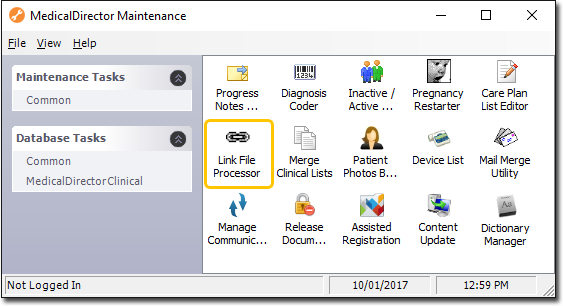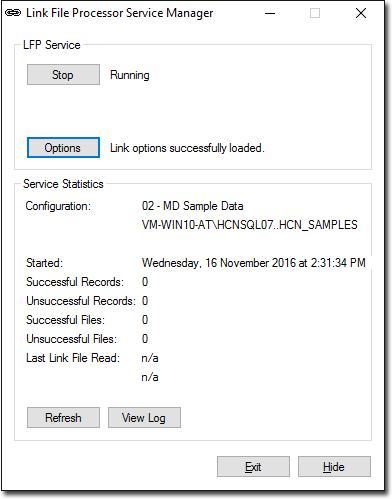About the Link File Processor
The Link File Processor utility provides continuous demographic synchronisation between;
MedicalDirector Clinical and Bluechip, or
MedicalDirector Clinical and a third-party front-desk (patient billing) application.
MedicalDirector recommends that the Link File Processor is not used at sites running both MedicalDirector Clinical and Pracsoft.
The Link File Processor reads patient demographic data from a Patients.IN file. This is a text file that a billing package writes to when you create a new patient record (or modify an existing patient's record) in the billing package. Such changes are written to the Patients.IN file, and the Link File Processor reads this file periodically, importing any data it finds to Clinical.
The Link File Processor only processes the Patients.IN file when it detects a change to it.
If the Patients.IN file cannot be processed, another attempt will be made in 10 seconds, or when the Patients.IN file is next modified.
If the Patients.IN file is too large to be processed (based on the file size limit you have specified - see Step 6 below) the Patients.IN file will be renamed to Patients.in_yyyyMMddhhmmss.BAK. A note of such is also added to the Link File Processor Log.
Activating and Configuring the Link File Processor
The Link File Processor is initially activated via MedicalDirector Maintenance, and once active runs as a Windows Service. Configuration of the Link File Processor is managed via the LFP Service Manager. Configuration requires your MedicalDirector User Name and password.
Locate and double-click the MedicalDirector Maintenance icon ![]() on your desktop. The MedicalDirector Maintenance window appears.
on your desktop. The MedicalDirector Maintenance window appears.
Select the Database Tasks > Clinical menu item.

Double-click ![]() The first time you run the LFP Service Manager utility, you will be prompted that you must configure it before it can be activated.
The first time you run the LFP Service Manager utility, you will be prompted that you must configure it before it can be activated.

Click OK The LFP Service Manager appears. Initially, the LFP Service Manager will indicate that it has failed to start. This is because it requires you configure a few settings first. Continue now to Step 5.

Click  You will be prompted select which database configuration you wish to configure, and to enter your MedicalDirector User Name and password for the selected configuration. The configuration you select here should be the one you wish to use the Link File Processor with.
You will be prompted select which database configuration you wish to configure, and to enter your MedicalDirector User Name and password for the selected configuration. The configuration you select here should be the one you wish to use the Link File Processor with.

Click OK The Link File Processor Service Options window appears. Select the Computer tab. From this tab you will configure settings for the computer you are working at i.e. each computer can be configured differently.

Consider the following options:
Ensure that the Read Link File from this Computer check box is ticked for linking to function. Removing this tick will deactivate the Link File Processor.
Indicate whether you wish to have the Link File Processor Service Manager loaded when Windows starts, on this computer.
Click  to select the path to the link file. This path should match the output path you have configured in your third-party billing package.
to select the path to the link file. This path should match the output path you have configured in your third-party billing package.
Enter the File Size Limit. If the file is larger than the size indicated here, the file will not be imported.
Tick the Delete Link File After Reading check box to delete the link file after reading it. The Link File should only be deleted if your billing product requires this.
Select the Database tab. From this tab you will configure settings for the MedicalDirector database(s) available to you. Settings made here are global.

(Optional) When you access this tab, the database selected will be that which you chose when you first opened the Options window. If you wish to configure a different database to that shown, select it now via the Database drop-down menu. If you select a different database, you will be prompted to enter your username and password for that database. It is important to note that the database you select here will be the database affected by the Link File Processor - ensure you select your intended database.

A number of advanced options exist for setting the link between MedicalDirector Clinical and a billing package. Many of these options should only be set when specifically instructed by MedicalDirector Customer Service or your billing package technical support.
Consider the following options:
Linked to Billing Package: Enables the linking of Clinical with your billing package. With this enabled, data such as immunisations for Medicare billing can be transferred from Clinical to the billing package. See 'Advanced Link Options' in the Clinical Help for detailed instructions on configuring Clinical to export this data.
Click  to indicate the format of the file you wish to have imported. You can also add a new format, or modify an existing one. MedicalDirector recommends the GENERIC ASCII V3 format.
to indicate the format of the file you wish to have imported. You can also add a new format, or modify an existing one. MedicalDirector recommends the GENERIC ASCII V3 format.
Generate a Pension Code... : If the billing package has a Pension Number or DVA Number recorded for a patient, but there is no corresponding Pension Code/Status for the patient's record in Clinical, it is updated to Pension/DVA accordingly.
Ignore the Pension Code... : If the billing package sends a blank Pension Number or DVA Number for a patient, Clinical will blank the corresponding Pension Code/Status for the patient unless this check box is ticked.
Remove Quotation Marks from Name Fields: It is recommended that patient names recorded in Clinical do not contain characters such as quotation marks. Ticking this check box ensures that they are stripped from a patient's name.
Strip Spaces from ID: Some third-party billing packages may use spaces as a prefix or suffix to a patient's ID number, such as " 12344" or "12344 ". It is recommended that you strip unnecessary space from these fields, unless your billing package requires them.
Delete Data in Clinical... : If patient data sent from a billing package includes fields with no data, Clinical will update its patient record accordingly. For example, if a patient's record in the billing package had a Medicare number recorded, which was then deleted, Clinical will also delete the Medicare number from its record of the patient. Use this feature with caution.
Click OK to confirm your settings. You will be prompted upon successful saving of your selections.

Click OK You will be returned to the Link File Processor Service Manager. It should now indicate that the service is running.

Click  to hide the Link File Processor Service Manager. It will remain active, and can be accessed via the
to hide the Link File Processor Service Manager. It will remain active, and can be accessed via the ![]() icon in your Windows System Tray.
icon in your Windows System Tray.